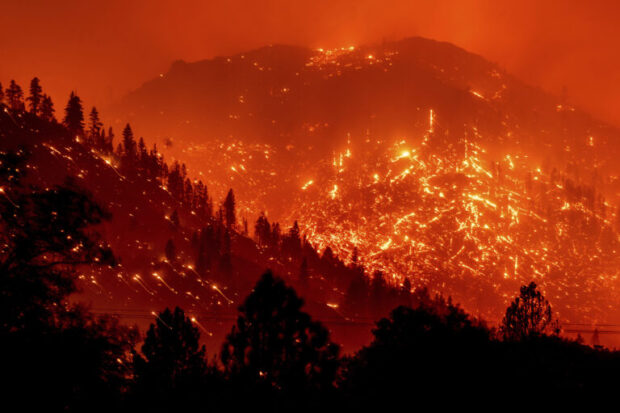Increasingly large and dangerous wildfires are being driven by the effects of climate change and more building in the wildland-urban interface (WUI), and while that notion may not be entirely new, the scope of the increase laid out on Thursday by a group of actuaries was noteworthy.
Members of the American Academy of Actuaries Extreme Events and Property Lines Committee discussed wildfire peril, wildfire modeling and potential responses from insurers, policymakers and others in a webinar moderated by Shawna Ackerman, chief risk and actuarial officer at the California Earthquake Authority. The speakers were Dave Evans, a consulting actuary at Milliman, and Howard Kunst, chief actuary at CoreLogic.
“You can see, over the last few years, 2017-2022, the significant increase in the number of structures destroyed,” Kunst said.
He added: “We’re seeing these fires are becoming much bigger. We are seeing a significant increase in the number of structures that have been damaged or destroyed in the United States.”
Two factors he called out that may help account for the increased risk are climate change, which has had a hand in increasing winds and drought, and urban conflagration (more homes in the wildland-urban interface).
Winds have been a big driver of extensive losses in the wildfires, according to Kunst.
“We’ve seen over the last few years…that winds have become very important,” he said.
Much of what was said on the webinar echoed the committee’s new paper, “Wildfire: An Issue Paper—Lessons Learned from the 2017 to 2021 Events,” which highlights key areas pertaining to wildfire risk, as well as the impact to the insurers and reinsurers.
The paper notes several factors that have led to the increase in wildfire events over the past few years, such as the impacts of climate change and population shift toward the wildland-urban interface.
“The recent significant wildfire seasons have highlighted the need to continue researching and understanding this peril,” the paper states. “It is critical to the future of the insurance market that insurers and regulators find ways to work together to appropriately price and assess this risk in order to provide an insurance market with stable rates, robust coverages, incentives to mitigate and increased consumer choice.”
The paper notes that 2017 was the “start of what has been observed to be the most active few years on record,” and that the costs of fighting fires and the risks to property owners in exposed areas is increasing.
“The fire suppression and management costs of wildfires are increasing, with U.S. Forest Service costs often exceeding $1 billion in annual expenditures since 2000,” the paper states.
“The risk to property owners due to wildland-urban interface fire is projected to increase in California. This is due to population growth and development in southern coastal California, the Bay Area and north of Sacramento—increasing wildfires near these areas.”
The paper also keys in on climate change.
“Climate change is thought to impact annual rainfall patterns, making winters wetter and summers hotter and drier,” the paper states. “This generally leads to a growth in healthy vegetation, followed by a drought that turns the vegetation into potential wildfire fuel. Ignitions from natural sources (such as lightning strikes) may also see an increase, which will result in a higher frequency of wildfires. Combining all of this with the warming climate means that wildfire season will continue to expand, contributing to a greater risk of more frequent and severe wildfires.”
Evans said that California is the state that has been most impacted by the increased wildfire activity.
From 1991 to 2016, the state saw five fires that destroyed 1,000 or more structures, according to Evans.
“Since then, there have been 13 fires that have destroyed over 1,000 structures,” Evans said. “I think this really paints the picture of how extreme it is.”
He echoed the sentiments in the paper: that building in the wildland-urban interface and climate change are the two big drivers of the increased destruction.
Evans also talked about price increases, nonrenewals and high-risk wildfire policies in California.
“From 2015 to 2018 nonrenewals were pretty consistent, and then in 2019 there was a very large jump, about a 25 percent increase in nonrenewal,” he said.
He said many of those consumers were driven into the California FAIR Plan as well as into the surplus lines market.
The paper also calls for wildfire modeling to catch up with modeling for other perils.
“Compared to hurricane and earthquake simulation models, acceptance and widespread usage of wildfire models are in an early stage,” the paper states. “The 2017 and 2018 wildfire seasons in California have been a wake-up call for insurers, reinsurers, regulators and property owners.
The 2017-2018 events heightened the awareness of wildfire risk and raised strong interest from stakeholders to understand and assess wildfire risks holistically using all available tools, including stochastic models. The focus on wildfire models has continued to increase as events from the 2020 wildfire season have challenged insurer stability and financial health, as well as the general availability of insurance.”
Regulators are also standing in the way of good wildfire modeling, according to the paper.
“A major factor in this limited use is regulatory acceptance of wildfire models and catastrophe models in general,” the paper states. “Insurers in California—with the exception of the California FAIR Plan—are still largely required to rely on historical loss experience for determining wildfire rates.”
*This article was originally published by Insurance Journal, our sister publication
(AP Photo/Noah Berger)





















 Breaking: Andersen to Replace Zaffino as CEO of AIG on June 1
Breaking: Andersen to Replace Zaffino as CEO of AIG on June 1  First Atlantic Hurricane Forecast for 2026 Suggests Season Close to 30-Year Norm
First Atlantic Hurricane Forecast for 2026 Suggests Season Close to 30-Year Norm  Is the AI Boom a Bubble Waiting to Pop? Here’s What History Says
Is the AI Boom a Bubble Waiting to Pop? Here’s What History Says 




